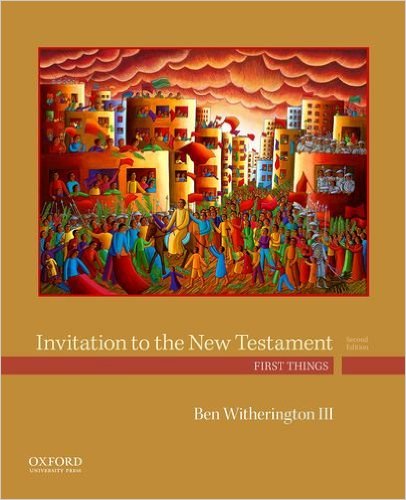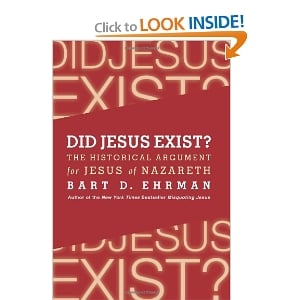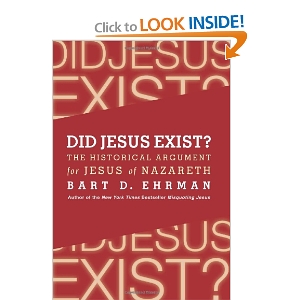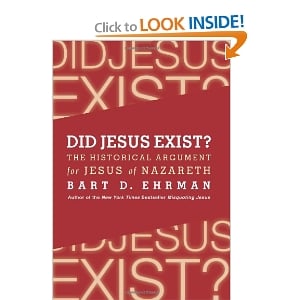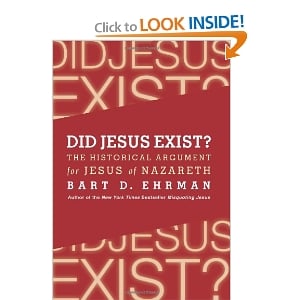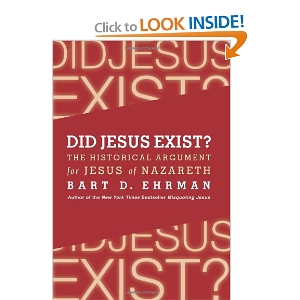
Q. On p. 180 you say that because the pericope about the woman caught in adultery is likely not an original part of the Gospel of John, that therefore it probably didn’t happen. Really? Why does that follow? Weren’t there many other things Jesus actually said and did that don’t make the cut of being included in this or that Gospel? Aren’t canonicity and historicity two separate issues?
A. Yes, good point. At that stage of my argument I was using a kind of short hand. The story of Jesus and the woman taken in adultery is not in John (or any other Gospel), and does not start appearing in our Greek manuscripts until the fifth century. So if anyone thinks that it is a historical story, s/he has a lot of explaining to do! In fact, I think it can be shown that the story originated as two different stories that were in circulation, independently of one another in the second, third, and fourth centuries, until they were combined in our canonical version; there may be some historical merit in one of these two stories, but the other is almost certainly legendary. That takes a very long article to demonstrate, however, and I will not try to do so here.
What I will say is that just because the woman caught in adultery is such a great story and a favorite of many readers of the Bible does not mean that it’s historical, or that it should be given a privileged place among apocryphal stories that originated outside our earliest sources, later in the Christian tradition. It has to be judged on the same historical grounds as any other story – in this case having as one of its clear disadvantages that we do not have it in its present form until the fifth Christian century – and when it is judged on those grounds, at least in its present form, it does not appear to be historical. (If it was historical, one has to ask why none of our Greek witnesses seems to know about it in its present form until the fifth century.)
Q. You place a good deal of stock in the criterion of dissimilarity, in terms of its ability to validate that something probably happened or was said, but at the same time you stress that this criterion cannot be used to disprove that something was said or done, in the way Robert Price uses it. Explain what you mean by this. Isn’t it also true that scholars like John Dominic Crossan rely too exclusively on the criterion of multiple attestation to establish authenticity (which would eliminate things like the parable of the Good Samaritan automatically) without also using the criterion of dissimilarity to compile a list of probably authentic traditions? In your judgment what is the balanced of proper way to use a combination of such criteria for authenticity?
A. In my view, to establish a tradition about Jesus as historical requires the rigorous application of historical criteria. The three most commonly used include the two you mention: multiple attestation and dissimilarity. The first indicates, as I pointed out in an earlier answer, that any tradition found independently in more than one source has a greater chance of being historical than a tradition found in only one source (since if it is in only one source, that source could have made it up; if it is independently found in several sources, however, none of them could have made it up, and so it must go back to a stage or a tradition antecedent to all three). The second criterion, dissimilarity, acknowledges that the early Christians were modifying and inventing traditions about Jesus, and if so, and if there is a tradition that seems to run *counter* to what the followers of Jesus would have wanted to say about him (e.g., from my earlier answer, that he was a messiah who got crucified), then THAT tradition is more than likely historical (because Christians would not have made it up).
Both of these criteria are what I would call “positive” principles, because they show us what probably is historical, rather than what is not. That is to say, if a tradition is found in only one source (e.g., the parable of the Good Samaritan is found only in Luke), that does not necessarily mean that it is not historical; it means that we cannot establish that it is historical using this criterion. So too, if a tradition about Jesus does coincide with what Christians would have wanted to say about him (e.g., that he was concerned about the poor and oppressed) that in itself does not mean that the tradition is not historical. It means that if you want to show that the tradition is historical, you cannot do so using this criterion.
The traditions about Jesus that are the most plausible are the ones that pass both criteria. Jesus’ crucifixion, for example, passes both; so does his having come from Nazareth; and his having been baptized by John the Baptist; and – well there are others.
The third criterion is equally important, but is a NEGATIVE principle. It says that any tradition about Jesus that cannot plausibly be fit into a first-century Jewish Palestinian context cannot be accepted as historically reliable. The principle is negative because it, unlike the other two, does not decide which traditions are probably historical; it decides which ones almost certainly are not historical. And so, for example, in later Gnostic Gospels Jesus is shown elaborating on the Gnostic myths about where the divine realm and the world we live in came from. Such complex myths cannot be otherwise located in Galilee in the 20s CE. The conclusion is near to hand that Jesus did not really deliver discourses on them, even though the Gnostic Gospels claim he did.
It is a mistake to use the positive criteria in a negative way. If a tradition of Jesus does not pass independent attestation or dissimilarity, we may indeed be suspicious of it – and usually there are other grounds for being so – but it is difficult to make a final statement about it. It simply does not pass the criteria. It would also be a mistake to use the negative criterion in a positive way. If a tradition about Jesus can be fit in his own context, that does not necessarily mean it is historical – it just means it that it could be.
Robert Price, though, uses dissimilarity to rule out everything – almost literally everything – in the Gospels as unhistorical, on the grounds that just about everything could fit some kind of Christian agenda or another. I don’t think the criterion is best used that way.
Other scholars like Dom Crossan try to put to many eggs in the basket of one criterion (in his case, independent attestation). I think one needs to use all the criteria, rigorously, rather than just one or the other.
Q. You makes the case for the conclusion that one cannot simply dismiss a tradition as unhistorical simply because it is tendentious or includes legendary material in it. Why is that sort of all or nothing conclusion that the mythicists sometimes make about a tradition invalid?
A. I think I answered that question in my previous answer. At least I meant to do so.
Q. Mythicists seems to often uses the interpolation theory to explain away NT texts that are inconvenient to their agendas. Yet it is also true that some NT scholars use interpolation theories to the very same end, even when there is apparently no textual basis for the interpolation theory. Explain how the mythicists appeal to interpolation is special pleading, whereas it is not when some NT scholars resort to such a theory (take for example the case of 1 Cor. 14.33b-36, which is displaced in some manuscripts but to my knowledge there are no manuscripts that omit it altogether).
A. A theory of interpolation argues that there are passages in the New Testament that were not originally there, even though they are still found in all the surviving manuscripts. When a passage (whether several verses, a single verse, or part of a verse) is not found in one or more manuscripts, then the decision whether it was originally in the NT is based on textual criticism. Scholars have to decide then which manuscript(s) more likely presents the oldest form of the text. But when all the manuscripts agree, and one wants to claim that they are all wrong with respect to the oldest form of the text, that involves arguing that at a very, very early stage of the transmission of the text (when it was being copied), someone inserted a verse (or verses, or part of a verse) that came to be found in all our surviving manuscripts. That would be what we mean by an interpolation.
In my opinion, there is no reason, in theory, to deny that there could be interpolations in the New Testament – that is, places where all our manuscripts include a passage (a verse, part of a verse, several verses) that was not originally put there by the authors. This is especially the case in light of the fact that we don’t start getting relatively complete manuscripts of the New Testament until well over a century after the books of the NT were written. At the same time, I think that if someone thinks a passage was an interpolation, there needs to be very, very, very compelling reasons for thinking so.
In almost every instance in which scholars have suggested that there are interpolations, I think the evidence is not compelling. The one instance that I think is compelling is 1 Cor. 14:34-35. I don’t need to give the evidence here. But I find it completely convincing. I should say that whether the verses are original or interpolated does not matter much to me personally. And that’s precisely the problem with many instances of alleged interpolation: it often happens that the scholar who proposes an interpolation has a vested interest in the matter, because if the verses are in fact original, then his or her particular view of things/interpretation is more or less destroyed.
That happens to be the case with the mythicists, as I repeatedly show in my book. Whenever there is a passage that contradicts their views, they invariably claim that the passage is an interpolation. This is what I have called “interpretation by convenience.” If a passage contradicts your view, then the most convenient way to deal with it is by claiming that “originally” in fact it supported your view, but someone came along and changed it. And so, for example, some mythicists “take out” the references to Jesus in Paul, claiming they were not original. And on what grounds? Because Paul doesn’t mention Jesus! That, obviously, is circular reasoning. In any event, I cite a number of instances of this kind of proceeding Did Jesus Exist.
Here let me just say that every case of alleged interpolation needs to be considered carefully and on its own merits. In principle, none should be excluded. But to be accepted, there needs to be a LOT of compelling arguments.
Q. Mythicists seem not to take seriously actual archaeological evidence, for example the evidence that Nazareth did exist in Jesus’ day, rather relying on certain kinds of philosophical, logical, and history of religions kinds of arguments to make their case. This seems odd since they are trying to make historical points about someone not existing or something not happening in the past. In any case, you make the point that the historical existence of Jesus does not stand or fall on whether Nazareth actually existed. Can you explain why this is so?
A. Yes, whether or not Jesus came from Nazareth may be an important historical question, but unlike what some mythicists think, the very existence of Jesus does not hang on the answer. As background: many mythicists have claimed that the town of Nazareth in fact did not exist in Jesus day. On that ground, they argue that Jesus therefore must have been made up. But the logic of this statement involves a complete non sequitur. Look at it this way. Suppose the birthers are right and that Barack Obama was not born in the United States. (I think they are way off base and my knee jerks all over the place when they go on and on about forged birth certificates and so on; but suppose they’re right) Would that mean that he does not exist? Or suppose someone could show that in fact I was not born and raised in Lawrence Kansas (where, in fact, I believe I was born, and I know I was raised). Would that mean I don’t exist? If Jesus did not come from Nazareth, would that mean he didn’t exist? It’s a non sequitur.
The other problem, as I spell out at length in my book, is that the mythicists who claim that Nazareth did not exist in Jesus’ day are completely wrong. It did exist. We have indisputable archaeological proof. Ask any archaeologist of Palestine –absolutely any of them. Archaeologists, for example, have uncovered a farm in Nazreth that was functioning at the time of Jesus; and recently they have uncovered a house that was standing at the time; and they have found coins that were deposited there at the time. There is absolutely no doubt that Nazareth existed at the time. It wasn’t a big place. It wasn’t an impressive place. It was a fairly miserable little place. But it existed. I give some of the evidence in my book.
Q. Robert Price’s argument that the stories of Jesus are a giant midrash on OT stories about Moses and others, and so are completely fiction seems to ignore the fact that midrash is a hermeneutical technique used for contemporizing pre-existing stories. Talk briefly about the difference between how stories are shaped in the Gospels and whether they have any historical substance or core or not. (N.B. It appears that Crossan has recently made the same kind of category mistake arguing that since there are parables in the Gospels, that whole stories about Jesus may be parables, pure literary fictions).
A. In Did Jesus Exist? I try to make a major methodological point that there is a very big difference between saying that a story has been shaped in a certain (non-historical) way and saying that the story is completely non-historical. I make this point because authors like Robert Price have claimed that all the stories about Jesus in the Gospels are midrashes on stories found in the OT. By that he means, roughly, that the story of Jesus is shaped in such a way as to reflect a kind of retelling or exposition of stories about persons and events in the Old Testament. For example, the beginning of Matthew’s Gospel shapes the stories about Jesus to make Jesus appear to be a kind of “second Moses.” Like Moses, Jesus is supernaturally protected at his birth when the ruler (Pharaoh/Herod) seeks to destroy him; like Moses he goes down to Egypt as an infant; like Moses he comes up out of Egypt to the promised land; like Moses he passes through the waters (the parting of the Red Sea; the baptism); after which he spends time in the wilderness being “tested” (40 years; 40 days); after which he goes up on the mountain to receive/deliver the Law (Mount Sinai; Sermon on the Mount). The story of Jesus has evidently been “shaped” in light of the author’s knowledge of the story of Moses in order to say something: Jesus is the new Moses.
It is true that a number of stories about Jesus in the Gospels (not all of them though!) have been shaped as a kind of midrash on the OT. But the key point to make is that there is a difference between shaping a story and inventing a story. As I argue in my book, it is very easy indeed for us today to shape stories of important historical figures when we tell about them. And so we have standard sets of motifs: for example, the “rags to riches” story (which presidential candidates often like to use in telling their own autobiography); or the “tragic hero” story. It would be oh so easy to tell the story of Richard Nixon as the tragic hero, whose tragic flaw led to his spectacular downfall.
But would that mean that Richard Nixon never lived? No, you would need to use other criteria (the ones I’ve enumerated) to decide whether he lived or not. So too with Jesus. Even if you could show that all the stories about him were shaped in light of the OT (you can’t show this; but suppose you could): that would have no bearing on whether he existed or not.



